Matrix Files
Where You Have Taken The Red Pill
Coin's Financial Course - Chapter V - THE FIFTH DAY.
« Chapter IV PDF File found here Chapter VI »
CHAPTER V.
It was a day of bulls and bears.
Tickets for seats had been printed the evening previous, and the ticket office had been opened in the morning.
Under Mr. Milliken's able management, notwithstanding the great rush, everything proceeded orderly; and after the seats were all sold, tickets for standing room readily brought the regular price, until the hall was packed. There were fully 3,000 people in the audience at two o'clock, when COIN appeared on the crowded platform.
The morning papers had twitted Professor Laughlin with his attempt to trap the little bimetallist by an unfair question, and the Times cited it as a sample of the methods used by the monometallists in their campaign of misrepresentations.
Lengthy comments were published editorially on the proposition of credit money based on labor, to be redeemed in services by the government.
The Inter Ocean said, editorially:
This kind of money would relieve the volume of money now used in transactions with the numerous post offices of the whole United States. It is no inconsiderable amount that is now required to perform this business, and the country would readily absorb a supply sufficient for a year's use in advance.
The Record said:
The Idea of money based on labor is a new one, but the plan is so practical and sensible, we can see no objection to it. To enlarge its use necessitates the government ownership of railroads. Government ownership of the telegraph lines would also add to the quantity of this class of money. It would certainly be sound money, redeemable in value received in the way of services. There would be no serious objection to government ownership of railroads and telegraph lines if all of the employees were disfranchised. If they had no power to vote there would be no danger of Caesarism from them. If the country was prosperous, and all branches of business were lucrative, the number of people desiring to hold a government situation would be materially reduced.
COIN'S answer to Mr. Scudder, as to the cost of producing silver, was approved by all the papers except the Tribune. But as that paper has become the unblushing defender of the classes, on the income tax, bribed and unjust property assessments, and every other iniquity that bears heavily on the many and favors a few, little importance was attached to what it said.
The monometallists that were such from personal interest had been piqued and disappointed at the headway the little bimetallist was making. His lectures were having an influence that speeches, books and articles could not have, as he was challenging contradiction of his statements. With such an audience of students of finance, authors arid bankers, these statements became admitted facts, that in their judgement were dangerous to their cause.
Two columns had been erected on the platform for this morning, and each of these were surmounted by a sheaf of wheat. This was due to the good taste of Mr. Milliken,by whose direction it had been arranged.
Three globes were on the platform. One was very large and the other two were very small. The little economist began his fifth lecture with a compliment to the Chicago Board of Trade, as the greatest institution of its character in the world. He then proceeded s follows:
"The total value of all the property in the world is about 450,000 million dollars.
"The available silver and gold money of the world combined is about 7,500 million dollars. The available gold money in the world is about 3,750 million dollars.
Their proportion in values to each other is represented by these three globes." COIN pointed, as he said this, to the three globes on the platform by him, and then picked up the two smaller ones and held them in his hand that the audience might see them. He then continued:
"The large one represents the value of all the real and personal property in the world; the larger of the two small ones represents the face value of the silver and gold in the world available for use as money; and the smallest represents the amount of gold in the world available for use as money. The proportion of these globes to each other is in the same ratio as the figures I have named.
"The large one is 60 times as large as this one," indicating the second in size, "representing silver and gold, and is 120 times as large as the small one which represents gold. In estimating this wealth of the world, property in some countries has been measured in a silver standard, in others in a gold standard, and in others in a standard gradually shifting from a bimetallic to a gold standard. All are based on figures of 1890.
QUANTITATIVE THEORY OF MONEY.
"The value of the property of the world, as expressed in money, depends on what money is made of, and how much money there is.
"All writers on political economy admit the quantitative theory of money. Common sense confirms it.
"To be correct this theory should always be applied to the quantity of redemption money.
"The issuing of wheat certificates against the wheat in your elevators, does not increase the value of the wheat; and the credit money issued against the redemption money, does not increase the value of property. It facilitates business based thereon. It enlarges business not values.
"The exchange value of primary money, for the property of the world, and vice versa, fixes the comparative value of the two.
"So if the quantity of money is large, the total value of the property of the world will be correspondingly large as expressed in dollars or money units. If the quantity of money is small, the total value of the property of the world will be correspondingly reduced.
"Property measures its value in money, and money measures its value in property. Money may increase in value by reason of its scarcity. When this is the case it buys more property property buys less money.
"The same law of supply and demand applies to it as applies to any specific class of property. You are of all men most familiar with that law of trade.
"If a certain number of bushels of wheat, is a normal supply for the World's use, and only half that quantity of wheat is produced, what is the result? Wheat is worth about twice as much per bushel as if the normal amount had been raised. A bushel of wheat will buy twice as much money as it would have bought if there had been a normal quantity.
"This rule applies to money. If there is a normal quantity, it measures its value in property at a certain price, subject to supply and demand affecting property only. If a normal quantity of money on a sound financial basis is maintained, values of property, and debts with reference to the time of contraction and payment, will be equitably adjusted, and fluctuations in values will depend on locality, and supply and demand of property, not money.

"At present the redemption money of the world in some countries is silver, and in some gold. Until recently the two were combined as primary money in most of the world under a law of free coinage, as we have before considered. Now silver is being destroyed as primary money, by a general movement that is deranging the commerce of the world, and the stronger nations are compelling the silver-using nations to settle with them on the gold basis.
"It is therefore proposed by the monometallists to measure the value of all property in gold, and to settle all debts in gold or in money redeemable in gold. If our debts were payable in wheat, wheat certificates which you handle every day would answer the same purpose, but the wheat would have to be in existence. So it is, if our debts are payable in gold if paid in other money it must be as good as gold. To be as good as gold the other money must be redeemable in gold, just as your wheat certificates, are redeemable in wheat.
QUANTITY OF GOLD IN THE WORLD.
"This policy rests upon the quantity of gold in the world.
"To carry out such a financial policy the world has, as reported by the director of the U. S. Mint, about 3,750 million of dollars in gold. Under any calculation it will not exceed at the present time 3,900 million dollars.
"But let us take the larger figure, 3,900 million dollars, and see what this amount means.
"The population of the world in 1890 was about 1,400 million. It is a per capita for the population of the world of about $2.50. In bulk it is about one-half the size of this nickel I hold in my hand." And as COIN said this he held up a 5-cent piece between his thumb and forefinger.
"The whole 3,900 million dollars of gold in the world, cast into cubic foot blocks, can be stacked up in the corner of this room in a space 22 feet square and 22 feet high, and space enough will be left of the 22 feet each way to box it in."
COIN here directed two boys, with a stick and tape line in their hands, to go to the corner of the room and measure off 22 feet square. This they did, with the assistance of the people sitting there; measuring from the corner 22 feet each way along the walls, and then out from those points 22 feet parallel with the first measurements. At this point the stick that one of the boys was carrying was placed in a perpendicular position, with the tape line reaching each way 22 feet to the walls.
COIN, continuing, said: "That stick is 22 feet high, and the inclosure indicated by it and the tape line is the cube of 22 feet. That space will hold all the gold in the world obtainable for use as money!"
COIN had spoken the last few words slowly but with great emphasis. A buzz of conversation went around the room with expressions of disbelief - such as "impossible" "it cannot be." Many had risen to their feet. Professor Laughlin was scratching his head. A mild state of sensation pervaded the entire room. The bimetallists were excited, but smiling, for they felt confident the little financier could not be cornered. In fact, he now had gold in the corner.
"A cubic foot of cast gold," continued COIN, after waiting for the effect of his last words, "weighs 19,258 ounces; multiply this by 480, the number of grains in an ounce, and you have 9,243,840 grains.
"This gives you the number of grains in a cubic foot of gold. There are 23.22 (to be exact) grains of gold in a dollar; divide the number of grains in a cubic foot by this, and it gives you the number of dollars, viz.: $398,098 in a cubic foot of cast gold.
"Now as there is $398,098 in a cubic foot of gold, by dividing this sum into $3,900,000,000, the outside estimate on the total gold supply of the world, we get as a result 9,796 cubic feet. The next question is, how much space will 9, 796 cubic feet occupy. Instead of extracting the cube root, which would be unintelligible to many, we will do it this way."
And with this he turned to the blackboard and multiplied 22 by 22, and that result by 22 again thus giving the number of cubic feet in a space 22 feet each way. The result was 10,648.
"You see," said COIN, "a space 22 feet each way, such as I have marked off in the corner of the room, contains 10,648 cubic feet. The total number of cubic feet of gold in the world is 9,796. So we could put it all in that inclosure, and have 852 cubic feet of space left, which you will admit is enough to box it all in, without requiring any more of the space of this valuable room than the 22 feet.*
"This block of gold could be put in the wheat pit of the Chicago Board of Trade," continued COIN, looking down at the members of the Board of Trade who had front seats, "and you could go on buying and selling wheat without its seriously interfering with your business."
With this COIN paused, and another buzz of conversation went around the room. Excited astonishment was upon the faces of all. There stood the figures, and no one could longer disbelieve.
*A cubic foot of water weighs 1,000 ounces. The specific gravity of cast gold is 19.258. Of silver 10.474. To get the weight of a cubic foot of gold or silver multiply 1,000 by these figures respectively.MEASURING THE GOLD.
"I will show you," he continued "how you can test this statement in a simple way. It is best that not the least scintilla of doubt should remain in your minds as to the truth of any statement that I make. The people have been too long deceived by misrepresentations; the world has been brought to its present condition of misery by deception on this subject and we must depend on truth to find permanent lodgement in your minds to root out the falsehood.
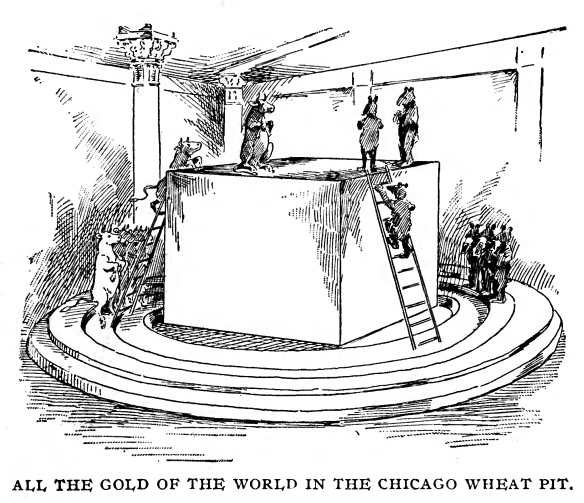
"I have here the teller of the Metropolitan National Bank with 125 twenty-dollar gold pieces, the number necessary for this simple test."
As COIN said this the teller of the Metropolitan National Bank stepped forward with a satchel in his hand.
COIN then laid a foot-rule down on the table and placed 9 twenty-dollar gold pieces by it. Those on the platform gathered around, while he explained to the audience that nine twenty-dollar gold pieces placed in a row was one foot long, and that hence eighty-one of them would go in a square foot.
He then stacked up the gold pieces a foot high, placing the rule by the side of them, and announced that the 125 in the stack measured one foot. And then said:
"Multiply 81, the number in a square foot, by 125, the number in each stack, to make them all a foot high, and you have as a result 10,125 twenty-dollar gold pieces. Multiply this by twenty, the value of each, and you get the value of this cubic foot of gold coins, viz., $202,500.
"A cubic foot of gold coin has in it 10 per cent of alloy; this, together with the unoccupied space between the stacks of coin, is nearly as much space as that occupied by the pure gold in the coins. So you can see that if it was pure solid cast gold the cubic foot would contain the $398,098+.
"All the gold in the world cast into solid blocks may be stacked behind the counter of the Metropolitan National Bank."
COIN then turned to the teller and invited him to a seat on the platform until he reached the silver illustration.
"Most of your offices would hold it all," COIN began again.
"It is in this quantity of gold that it is proposed to measure the value of all the other property of the world. Its significance is written in our present low prices and depression in business.
"When the transformation now going on in India, which is changing her from the silver standard to a gold standard, and when Mexico and South America, and the balance of the world are added to the gold standard, should such be the case, one pinch from that block of gold the size of a gold dollar (one-twentieth of an ounce) will be so valuable that it will not only buy two bushels of wheat, as it does now, but it will then buy four bushels of wheat.
"One-half that quantity will buy ten hours labor from a strong-armed mechanic. So much as you could put in the palm of your hand, will then buy a man's soul - a statesman's honor. It is breaking down the fabric of our institutions; driving hope from the heart and happiness from the minds of our people."
And with a voice low and impassioned that reached the finer fibres of every heart in that room, he added:
"Who can estimate the damage to the commerce and business of the world? Who can estimate the suffering that humanity has and must yet experience? In what language can we characterize the men behind the scenes who knowingly are directing this world to the gold standard?"
A man rising in the middle of the audience, exclaimed, with the accent of Ireland in his tones:
"Imps of hell unchained, banqueting in selfish glee upon the heart's blood of the world." It came with the Irish ring in the words, rich and mellow, yet breathing fire and vengeance - vengeance for wrongs seared into the human heart suddenly and forcibly realized. The words seemed to linger in the air as if searching for the objects of its hate. It was learned afterwards that his name was Dalton, a member of the steam fitters' union in Chicago. He was loudly applauded for his appropriate answer.
COIN rapped for order and continued: "We are not here to deal in sentiment - we are plain matter-of-fact people.
QUANTITY OF SILVER IN THE WORLD.
"It is proposed by the bimetallists to remonetize silver, and add it to the quantity of money that is to be used for measuring the value of all other property.
"In dollars at a ratio to gold of sixteen to one, there are about the same number of dollars of silver in the world as gold. The report of the director of our mint says there was in the world in 1890, in the form of silver coin and bullion used as money, $3,820,571,346.
"A cubic foot of silver weighs 10,474 troy ounces, and using 371¼ grains to each dollar, this will make a cubic foot of cast silver worth $13,544.
"You get this by multiplying the 10,474 by 480, the number of grains in an ounce, and dividing the result by 371 1/4, the number of grains in a dollar. You then want to divide the $3,820,571,346, the silver of the world, by 13,544, the number of dollars in a cubic foot. It gives 282,085 cubic feet of silver in the world.
"Can you comprehend what a quantity of silver this is? I will tell you how. It will make a block of silver sixty-six feet wide, sixty-six feet long, and sixty-six feet high.
"You can put it all - all the silver of the world - in one of the rooms of this building, and anyone entering at the main entrance on Michigan avenue would have to inquire in which room of the building the silver of the world was, before he could find it.
"It will go in the Board of Trade room and still leave sufficient space, I imagine, for you gentlemen to do some business on dull days."
COIN now had the teller of the Metropolitan National Bank hand him a satchel containing one hundred and fourteen silver dollars. With these he showed that sixty-four silver dollars would lay down in eight rows, of eight each, in a square foot, and that one hundred and fourteen laid one upon the other measured a foot in height; that a cubic foot would therefore contain 7,296 silver dollars.
He then explained that the alloy (one-tenth), and the space between the sixty-four stacks of silver dollars, would hold the other $6,248 of the $13,544 in a solid cast cubic foot of pure silver. He also stated that the gold and silver of the world obtainable for use as money, when mixed with its alloy and coined, could be stacked up in less than double the space it would occupy in solid cast blocks.
The little economist then continued: "All the silver in the world available for money can be stored in the room of the First National Bank of this city and the basement thereunder.
"This is the quantity of silver in the world, and it will be well for you to remember it when you hear some one talking about a flood of silver.
"We have heard a good deal about the treasury vaults at Washington groaning with silver, and more talk of enlarging them.
"The vaults under our treasury building can easily be arranged to hold all of the silver in all of the countries of the world used as money, either in coins, bars or bullion.
"You can empty all of the pockets of the people of the world of their silver, the bank vaults, the merchants' money drawers, the sub-treasuries, the children's safes, all India, Mexico, South America, England, France, Germany, Russia, Italy, Austria, the Netherlands, British America, China, Japan, and the islands, big and little, of the oceans, and you can put it all into this room, or in the basement of the Treasury building of the United States. [Applause]
"It is a matter of mathematical calculation and no intelligent citizen need be either alarmed or deceived."
With this statement COIN paused a moment, while people looked into each other's faces and back again at the speaker.
CHANGING THE MEASURE.
"Until 1873," he continued, "the primary money of the world was both silver and gold - at a parity. They were virtually one metal. The demand for primary money was met by the supply of both metals. The relative valuations of property to money, and money to property, adjusted themselves accordingly.
"Thus we had dollar wheat and 16-cent cotton in bimetallic measurement. A bushel of wheat went out into the market and purchased a dollar.
"Then came the abandonment of the use of silver as primary money by the United States, followed by Germany four months later, and then by the Latin Union., and recently by India.
"A new standard of measuring values was set up. Silver and gold combined was displaced by gold alone.
"Silver being deprived of this privilege - free coinage at the mints, and use as primary money - became property of the world, to have its value also measured in gold.
"As the standard for measurement in the countries making this change was now only one-half of what it had been, it meant the decline in value of all property.
"The demand for gold now became greater, and as other countries threw silver aside, the demand for gold still increased. It became more valuable - therefore, bought more property, silver included.
"As the effect of these changes began to be felt, prices declined. As the demand for gold increased, its value increased - just as the value of your wheat would increase if the double duty of both corn and wheat were put upon it.
"So the purchasing power of gold continued to increase - and this increase was indicated by what is known as the fall of prices. Silver was no longer primary money with us and it too as compared with rising gold declined in the market. It is the best thermometer we have to indicate the rise in gold.
"This scroll that I invite you to study," and here COIN unrolled a parchment and hung it on the wall, "gives you the decline in the price of silver, wheat, and cotton.
"We say 'decline,' but it would be equally true for us to say that these figures registered the rise in the purchasing power of money under this financial system that is based on gold.
"Our daily expression is that wheat or some other property has declined so much. Dun and Bradstreet reported last week an average decline in all property of one and 1-10 per cent.
"It would be a more intelligent understanding of the situation to say that the gold crop of the world - this crop that can be fenced in by twenty-two feet each way - had appreciated in value as the demand for it had increased.
"Remember that it has no way of expressing its value, except by what it will buy. The gold in a gold dollar may double or triple in value, but so long as it is the unit of value, it will still be called a dollar, and lo when expressed in terms of money no increase in its value will be indicated.
"It only expresses its value in its purchasing power.

"If a dollar buys a bushel of wheat, during a time when the supply of wheat is normal, and the conditions continuing normal, at a later time a dollar will buy two bushels of wheat then the dollar has doubled its purchasing power.
"We speak of declining prices, and do not think of the appreciation of gold. We speak of the sun coming up in the morning and going down in the evening. It is we that come up and go down. The sun is relatively fixed.
"Property is standing still and gold is going up.
"It is common now to hear the expression that the silver in a silver dollar is only worth sixty cents, or fifty cents, or forty-eight cents, as the case may be at the time. People do not stop to think what measure that value is being taken in. When we had a double standard, and silver was the unit, such a thing as its being worth less than a dollar was as impossible as it would be now for the gold in a gold dollar to be worth less than a dollar. Had gold been destroyed as primary money by the same nations, and silver made the standard, we could have had gold in the form of token money to-day, worth, say, fifty cents on the dollar as measured in silver.
AN ILLUSTRATION.
"Suppose both were destroyed as primary money, and a new standard of values was set up - and that standard was diamonds. Suppose a carat diamond was made the dollar or unit.
"And suppose gold and silver token money was used, of the weight and fineness now made, redeemable in this new redemption money.
"Under a double standard of silver and gold a pure one-carat diamond was rated at $50.00. A change therefore to the diamond standard, would contract values fifty times. Wheat under a double standard that was worth $1.00 on the farms, would under like conditions with a diamond standard, be worth two cents as expressed in the new standard, or diamond dollar. It could then be said that the gold in a gold dollar, and the silver in a silver dollar now was worth only about two cents. The demand for diamonds would become enormous, but as expressed in dollars a carat diamond would be a dollar. As expressed in purchasing power, it would buy fifty bushels of wheat. Wheat would be worth about two cents per bushel.
"Let me demonstrate. Say a one-carat diamond is now worth under a gold standard $25.00. If a carat diamond was adopted as the unit of value for our monetary system - one-carat declared by our law to be a dollar, and diamonds the only money of redemption, you would not say that a carat diamond was worth $25.00; but you would say that it was one dollar, or was worth one dollar.
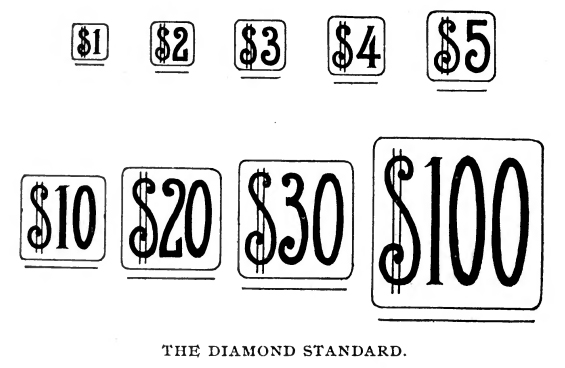
"As expressed in dollars and cents it would pull everything down with it. Wheat now worth fifty cents would be worth one twenty-fifth of fifty, or two cents.
"You could then make fun of gold as some of our papers are now doing with silver, and say that the gold in a gold dollar was only worth two cents. It could be urged as a reason for not remonetizing gold with as much force as the same argument is now used against remonetizing silver. [Applause.]
"Those who have been deceived by this cry of a fifty-cent silver dollar have only themselves to blame, and if they are not money lenders 'they have been paying the fiddler.'"
ANOTHER ILLUSTRATION.
"We express values in dollars, the unit of our monetary system. That unit is now the gold dollar of twenty three and two-tenths grains of pure gold, or twenty-five and eight-tenths grains of standard gold. If we were to cut this amount in two and make eleven and six-tenths grains pure gold a unit or dollar, we would thereby double the value of all the property in the United States, except debts.
"If we were to double the weight of the unit or dollar by putting forty-six and four-tenths grains in it, we would thus reduce the value of all the property in the world, as expressed in dollars, except debts, as they call for so many dollars.
"If you don't understand this proposition as I have stated it, you will by enlarging the scale. Keep on adding gold to the dollar, till it takes one hundred grains - five hundred grains- one thousand grains - to make a legal unit or dollar. Go on making it larger till you have all of the gold in the world in one thousand units, or dollar pieces.
"Who could give up property enough to buy one of them? To buy a single dollar? Suppose you owed a note calling for $100.00 payable in gold, one-tenth the gold of the world - how could you pay it? Think of the property that would have to be slaughtered to get it.
"Carry the illustration still further and put all the gold in the world in one dollar. A note for one dollar would require all the gold to pay it. When you reduce the number of primary dollars, you reduce the value of property as expressed in dollars accordingly, and make it that much more difficult for debtors to pay their debts.
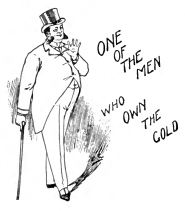
"And yet this is the kind of injustice that was committed when silver was demonetized. It struck down one-half the number of dollars that made up our primary money and standard of values for measuring the values of all property. It reduced the average value of silver and all other property one-half, except debts.
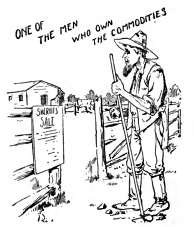
"It is commonly known as the crime of 1873. A crime, because it has confiscated millions of dollars worth of property. A crime, because it has made thousands of paupers. A crime, because it has made tens of thousands of tramps. A crime, because it has made thousands of suicides. A crime, because it has brought tears to strong men's eyes, and hunger and pinching want to widows and orphans. A crime, because it is destroying the honest yeomanry of the land, the bulwark of the nation. A crime, because it has brought this once great republic to the verge of ruin, where it is now in imminent danger of tottering to its fall. [Applause.]
"Pardon me for an expression of feeling. We are not here to comment on the effects of demonetization, but to learn what money is, and wherein our financial system has been changed."
The little speaker, without intending it, through a feeling of honest indignation, had burst forth in a recital of this catalogue of crimes. It had a perceptible effect on the audience. His earnest eloquence was melting hearts that never before had thawed to the presentation of the subject. It is one of the wonders of the world - how the people have been so slow in grasping the financial problem - in learning what it is that measures values, and that the lesson should have to be learned through an experience so bitter.
"And now," continued COIN, "if my explanation of what is known as the fifty-cent silver dollar is not plain and satisfactory I want to hear from you. It also accounts for fifty-cent wheat."
Mr. Ed. Pardridge, a noted bear operator on the Board of Trade, who had been listening attentively, here stood up. He had commenced bearing wheat in 1893, when it was 80 cents, and to the surprise of every one had continued confidently to sell it short down to 53½ cents, until he had made something like two millions of dollars and was still hammering away. With a smile on his face and a wink all around him at his fellow members of the Board, he said:
"I have understood the relation of redemption money to values for now little over a year, and have profited by it; but you," addressing himself to COIN, "have given the snap away." Then amidst laughter and applause Mr. Pardridge took his seat.
Mr. Chas. Henrotin, a Board of Trade operator, then said that he had read in a morning paper, a statement signed by a Mr. Wheeler, that wheat in 1859 was as low as it is now, and as bimetallism was then the law, he would like to know how that was? Also that corn in 1873 was about the same price (38 cents) that it is now, and he would like to hear from COIN as to that point. Unless, he said, there is a satisfactory answer as to why corn was as low in 1873 as the present low price, he could not satisfactorily change his present views, which were for the gold standard.
COIN replied: "The statement that wheat in 1859 was as low as now is not true.
"The secretary of your Board has the bound journals of a trade paper published in this city before the war that escaped the great fire. They are shown to any one who calls there. I have them here.
"They show that the average price of No. 2 red winter wheat for 1859 was $1.10 per bushel. The average price for the month of May, 1859, was $1.35.
"On this 11th day of May, (1859)," said COIN, turning to one of the books of the bound journals, "No. 2 Red wheat is here quoted at $1.38 and $1.40 per bushel. Wheat is now 54 cents a bushel; so this Mr. Wheeler is much mistaken when he says that wheat or anything else was as low in 1859 as it is now.
"We will take some other things," continued COIN. "I now hold in my hand the statistical abstract of the United States issued in 1892 by the Bureau of Statistics of the Treasury Department. Any of you can get it by writing to the treasury department. It brings the annual average prices down to 1892.
"On page 341 we see that the average price of cut nails in 1859 was, per 100 pounds, $3.86. In 1892, $1.83. Now they are about $1.00.
"On the same page the average price of pig iron in 1859 was $23.38 per ton. In 1892, $15.75; now it is about $12.00.
"On page 334 we find that the average price for 1859 of cotton was 12.08 cents per pound. In 1892, average price 7.71 cents per pound; now it is about 7 cents.
"On page 335 we find the average price for 1859 of fine washed clothing, Ohio fleece wool, was 60 cents. For 1892, 30 cents.
"From this trade journal you will see that corn in 1859 was worth 65 cents.
"All other values on an average have declined like these I have just read. So you see that prices were not as low in 1859, or before the war, as they are now.
"Now, as to that part of your question as to the low price of corn in 1873," said COIN, looking toward Mr. Henrotin.
"What you say about the price of corn in 1873 is true; but I want to call your attention to the cause of it.
"Corn does not seek distant markets like wheat. This is partly on account of its small price per bushel. It cannot always stand the freight. Its use is not so general as wheat, and it seeks the home market.
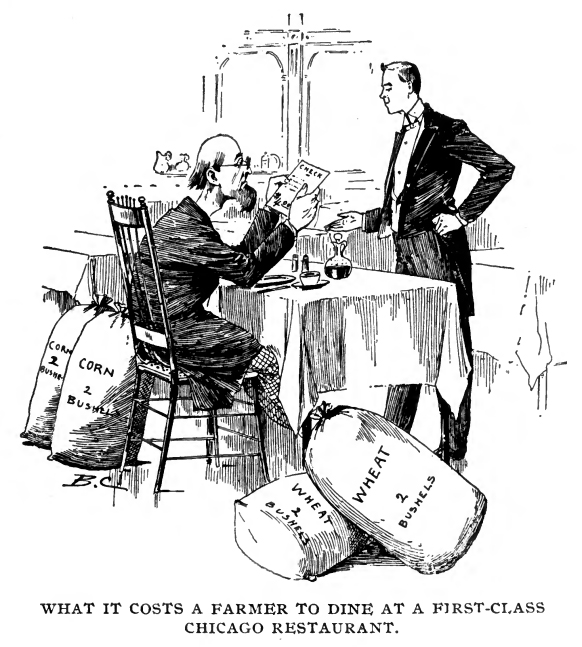
"On page 215 of the report of the Chicago Board of Trade for 1892 you will find that the corn crop of the State of Illinois, for the year 1872, which controlled the market price for the spring and summer of 1873, was 217,628,000 bushels; while by this year's report the crop for 1893 which controls the present price, was 160,550,470 bushels. The demand for corn now, with nearly double our population, is greater than it was in 1873, and yet in 1873 the corn crop was fifty-seven million bushels greater in this state than it was last year. This over-production in 1872 accounts for its low price in 1873. The gold standard accounts for its low price now.
THE DEBTS OF THE WORLD.
Mr. H. F. Earnes, president of the Commercial National Bank, put this question to COIN:
"Suppose values do decline and get on a lower plane. Can't the farmer who gets 50 cents for his wheat buy as much of this world's goods with that 50 cents as he formerly could with a dollar? And if this is true, and I think it is, wherein does it make any difference?"
And he sat down thinking he had accomplished what Professor Laughlin, Mr. Gage, Mr. Kirk and a dozen others had failed to do, viz., stump the little speaker.
He probably got the cleanest knockout and hardest fall of them all.
COIN turned to one of the boys who had helped to measure off the twenty-two feet in the corner and gave him some direction.
The boy went out into the anteroom, and a moment later returned, rolling a rubber globe or ball before him about half the size of the largest one on the platform.
The people moving to make way, the lad rolled it to where COIN was standing. The little schoolmaster putting his hand on it, said:
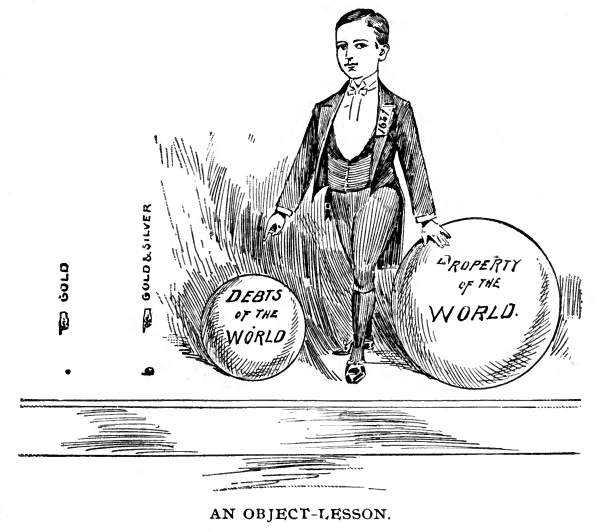
"This ball, as proportioned to the largest one, indicates the debts of the world, which are, if we include debts of all kinds, about 200,000 million of dollars at the present time. The total value of all the property of the world in 1890 was about 450,000 million.
"This value has since been shrinking, and will continue to shrink until it is about one-half its present size as represented by this largest ball.
"But this ball that represents debts will not decrease any. Its present tendency is to grow larger.
"When this ball," indicating the one representing values of all property, "has shrunken to half its size, it will be about the size of this one representing debts.
"The history of nations shows that when the debts of a country are two-thirds of the value of all its property, disintegration sets in. Strikes - riots - revolution - provisional governments, as with our neighbors in South America at the present time.
"When you reduce wheat to 50 cents, and all other property accordingly, you don't reduce debts at all. You only make it harder to pay them.
"A note executed five years ago which 1,000 bushels of wheat would then have paid, now takes about 1,500 bushels to pay.
"Though we have paid since 1869 about 5,000 millions on our public debt in principal and interest, and have reduced the principal from 2,700 million to 1,000 million, it will now take as much of our property to pay the 1,000 million as would have paid the whole 2,700 million in 1869.
"A farmer may buy calico with his 50-cent wheat money at a like cut in values, but he cannot get the same favor shown him on his debts.
"The property of the money lender - notes, bonds and mortgages - does not shrink. The mortgage will eat the property owner up.
"'Ah!' you may say, 'everybody is not in debt; one-half of the people may be, but let them liquidate and start over, then times will be good."
"But everybody, except the money lender, is in debt. Your city is in debt twenty million, and you owe your part of it. Your county is in debt. Your state is in debt. Your general government is in debt.
"You are paying your part of the interest on all that; and your taxes in this city at the rate of 8 per cent on the assessed valuation is evidence that you are all in debt.
"Those who are personally in debt will only become bankrupt the sooner.
"The total debts in the United States, national, municipal, state, county, corporate and private, is now estimated to be about 40,000 million of dollars.
"The railroad bonded debt is 5,000 million, or about one-eighth of the whole amount.
"The interest on 40,000 million, at an average rate of 6 per cent per annum, is 2,400 million. Now, when you consider that the total money supply of the country is only about 1,600 million, and that interest money is going principally to the East, you can see what a great sponge this debt is, to come West twice a year and soak up your money and take it away.
"When your neighbor has sent all of his money off he has none left to spend with you.
"There are two ways ordinarily of getting this money back that goes East. One is to sell something to them at a profit. We are not now doing that. The other is to borrow it. So many of our friends have borrowed, that while they cannot borrow any more, it has made it unprofitable for those who can borrow to do so, as no business ventures are now profitable.
"The only money coming back to us at present from the East, which first goes there to pay interest, is about one hundred and sixty million a year paid by the government in pensions; salaries paid to government employees, and money received in payment for produce on which there is no margin or profit.
"On one hand the law of the land says these debts must be paid, and there are the courts and sheriffs to enforce it.
"On the other hand, the people cannot pay, as a new monetary unit makes it impossible. The law spends its force by confiscating the property of the people. The people will retaliate * * *. Under the effects of this legalized robbery, which has been in operation for twenty years, the future of the republic looks serious and threatening.
"While not directly interested in our neighbor's debts, we are indirectly; and general paralysis may come to our business on that account.
"In adjusting ourselves to a lower plane of prices, we are at once confronted with the fact that debts do not depreciate with other property, and that on account of its great size it becomes an oppression affecting all, more or less, and directly confiscating the property of millions.
"To expect these debts to be paid under present conditions, when it is so far beyond the power of the people to pay them, is too much. It is like trying to fit a 6-foot man to a 3-foot coffin. It will mutilate the remains to attempt it.
"Many other things do not, also, readily adjust themselves to a lower plane of prices.
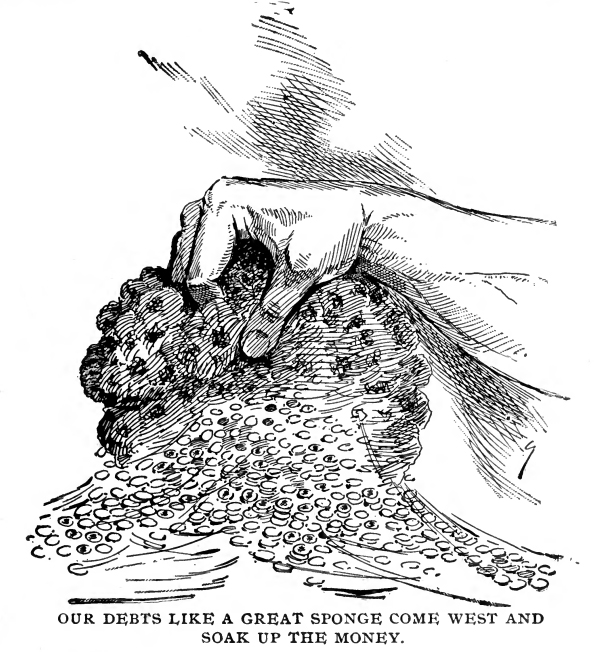
"Suppose the proposition embraced in the question to me was made to the now irritated farmers, and one of them was to go forth to test it, and see if he could buy as much of this world's goods with 50 cents as he formerly could with a dollar.
"We will suppose, before starting, he goes to pay his taxes. He will find that his 50-cent wheat will not pay as much as his $1.40 wheat did in 1873. He will find his taxes just as much, and it will take all of twice as much wheat to pay them as in 1873.
"While passing out of the Court House suppose he meets a county official and should ask him what salary was paid to his office in 1873 and now. The answer would be the same number of dollars now as in 1873. The same is true of city, state and national officers, also with the army, navy and officials abroad. The 50-cent wheat would only pay about one-third as much in each instance. He starts for the depot and to get there he takes a street-car. He finds the fare the same as in 1873. He gets on a Pullman car to find the cost the same as in 1873. He registers at a first-class hotel. He finds the cost about the same as in 1873. He sends a telegram, and finds it costs the same as in 1873. He gets a shave with the same result. He buys tea and coffee, with the same result. He gets back home and goes to his bank to borrow money. He finds interest, except in cities on first-class loans, about as high as in 1873. Should he now meet the man who told him that his 50-cent wheat would buy as much of this world's goods as it ever did, it might result seriously for the other fellow." [Laughter and applause.]
And with a smile and a graceful bow COIN retired from the stage. The lecture was over. It had been full of "meat," and the bulls and bears knew more than they did before. If they had learned nothing else than that all of the gold and silver in the world could be put in the main room of the Chicago Board of Trade their attendance on the lecture gave rich returns for the time spent. The bears on the Board the next day were more numerous than they had been in many months.
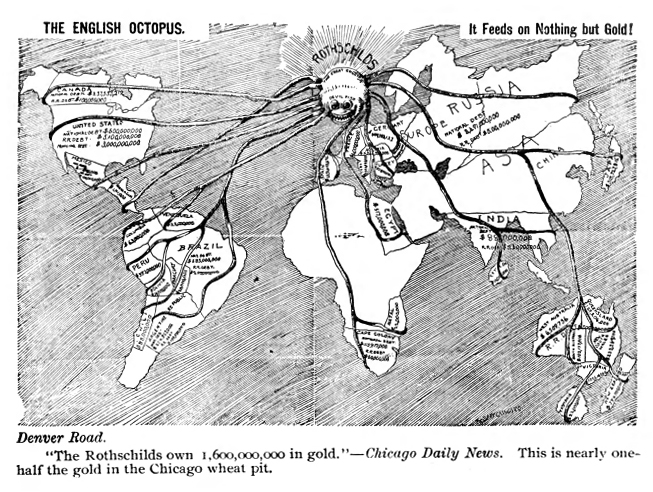
A PARABLE
A mother quail with her young quail brood had a home in a wheat field. When the wheat was ripe and the harvest time was come, the little quails suggested to their mother that it was time to move. While they were discussing it, the owner of the field came near, and was heard to say to some one with him, that he was going to get his neighbors to help him harvest. The mother quail said to her young. "We will not move yet." Several days passed by and the wheat had grown very ripe, The quail again heard the owner say that he was going after some friends over in another neighborhood, to help him cut the wheat. The mother quail said to her young, "We will not move yet." A few days later, when the wheat was so ripe it was falling and going to waste, the quails heard the farmer say, "I am going to cut the wheat myself." The mother quail then said to her young: "Now we will move. The wheat is to be cut." From an old Scrap Book.